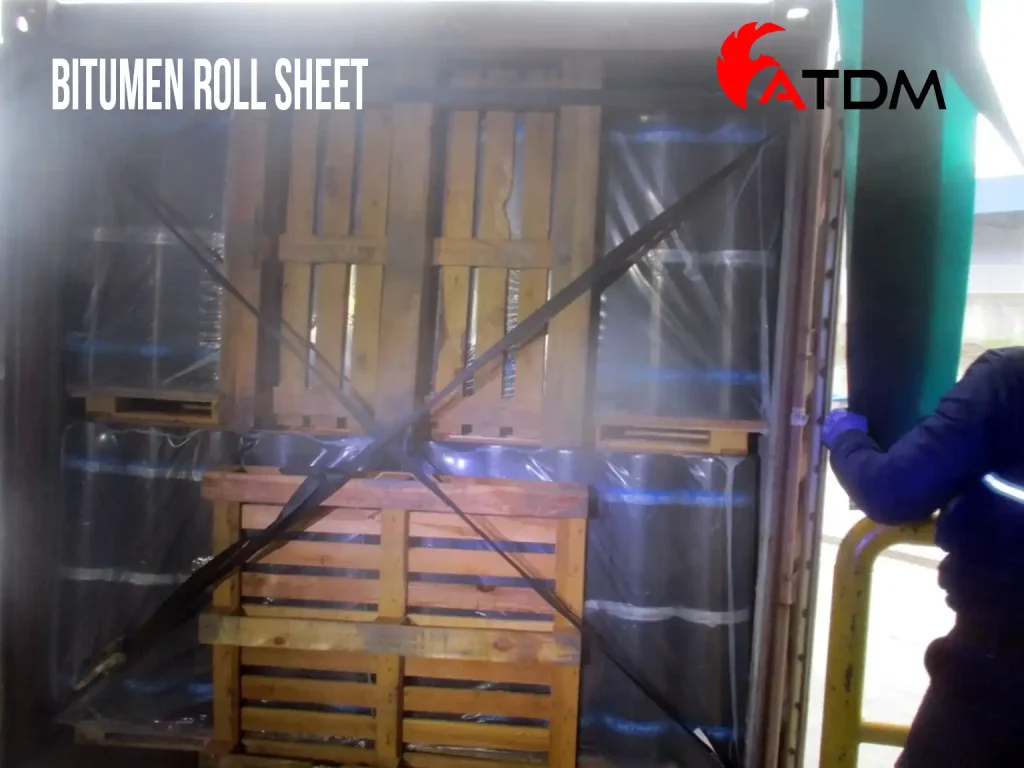
Bitumen roll sheet, also known as bitumen membrane roll, bituminous roofing sheet, or bitumen waterproofing sheet, is a high-performance waterproofing material used in foundations, roofs, basements, and wet areas. Produced using a mixture of bitumen 60/70 or blown bitumen and polymer modifiers (APP or SBS), these sheets offer excellent durability, flexibility, and water resistance.
HS Code
HS Code: 68071000 – Roofing and waterproofing materials made of asphalt or bitumen, in rolls or sheets.
Types of Bitumen Roll Sheet
Bitumen membranes are available in multiple configurations depending on application needs:
Single Layer Membrane
Double Layer Membrane
Aluminum-Coated Membrane
Self-Adhesive or Torch-Applied Membrane
Roll Sheet Production Process
Bitumen sheets are manufactured by combining the following raw materials:
Base: Bitumen 60/70 or Blown Bitumen
Reinforcements: Polyester, Tissue, Aluminum Foil (14–16 microns)
Backing: Plastic Film, Talcum Powder, or Gunny
The production line involves the following steps:
Feeding base material (tissue, polyester, and aluminum) into the mixer.
Applying primer or molten bitumen.
Passing the product through rollers and cooling via an 11-meter water pool.
Automatic rolling, cutting, and stacking via elevator.
Production Line Specifications
Length: 35 meters
Width: 1.6 meters
Height: 5 meters
Cooling Length: 11 meters
Elevator Capacity: 30 meters (continuous feed)
Key Features of BITUMEN ROLL SHEET:
Modular design with easy assembly using nuts and bolts.
High-quality motors, gearboxes, and bearings.
Polished industrial seamless pipe rollers with double flanges.
Automatic rolling, cutting, and drying (with fin fan system).
Optional boiler connection for heating.
Part List of Bitumen Roll Sheet Production Line
Bitumen Mixer (for primer preparation)
Conveyor System
Bitumen and Water Pumps
Elevator Unit
Oil Boiler
Cooling Pool
Air Conditioning & Ventilation
Reactor for Blown Bitumen Conversion
Material Comparison: Bitumen 60/70 vs Blown Bitumen (Mazut)
| Property | Bitumen 60/70 Roll Sheet | Blown Bitumen Roll Sheet |
|---|---|---|
| Bitumen Source | Penetration Grade 60/70 | Heated Mazut (Vacuum Bottom) |
| Durability | Higher | Moderate |
| Softening Point | Consistent | Variable (60–70°C) |
| Flexibility | Better (Especially with APP/SBS) | Lower |
| Common Use | Roofs, foundations, insulation | General waterproofing |
Applications of Bitumen Roof Sheet
Bitumen roll sheets are ideal for:
Roof Waterproofing
Foundation Insulation
Tunnel and Bridge Deck Protection
Basement and Underground Structures
Wet Areas like Bathrooms & Kitchens
Advantages of Bitumen Waterproofing Sheets
Long shelf life (up to 10 years in storage)
Easy to apply using heat (torch-on)
Strong adhesion to concrete, metal, and wood
Superior resistance to UV, aging, and weathering
Replaces traditional asphalt and gunny waterproofing
Evolution from Traditional to Modern Waterproofing
Before the advent of roll sheets, buildings relied on gunny bags, hot asphalt, and manual labor for sealing. The introduction of Bitumen roll sheets has revolutionized waterproofing, offering faster application, consistent quality, and long-term protection.
If you need assistance with supplying, exporting, or bitumen roof sheets, or require custom grades (APP, SBS, Aluminum-coated) tailored to your project, feel free to contact us—your trusted bitumen supplier in Dubai and Turkey.
A bituminous membrane is a waterproofing material made from bitumen combined with polymers such as APP (Atactic Polypropylene) or SBS (Styrene-Butadiene-Styrene). It is commonly used in roofs, basements, foundations, tunnels, and wet areas to prevent water penetration and protect structures from moisture damage.
APP membranes offer excellent UV and heat resistance, making them ideal for hot climates and exposed roofs. SBS membranes provide superior flexibility and elasticity, making them suitable for areas with temperature variations or structural movement. Both are durable, but the right choice depends on climate and application.
es, bituminous membranes can be installed on a variety of surfaces including concrete, metal, wood, and brick. The surface must be clean, dry, and primed before application to ensure strong adhesion. For complex or irregular surfaces, self-adhesive or torch-applied membranes offer flexible installation options.